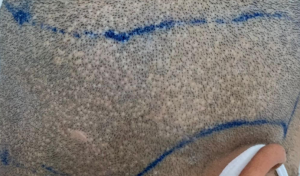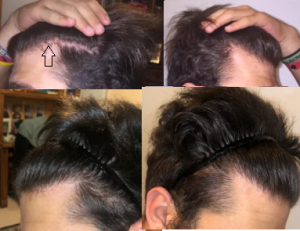What constitutes to be as a “massive” shed which retreats my hairline – in all honesty, may not be all that bad to someone with more severe balding. I did shed a ton, but my hair was largely intact. My hairline, however – was a different story.
I also think, due to the shifting of phases between hair follicles – a hair shed is almost inevitable and is certainly a sign which isn’t only regular, but honestly quite indicative of treatment working. Whilst you, personally, may not have encountered sheds, I have seen you interact with countless people on forums who do mention it.
For peace of mind purposes, it should be clearly stated; if you notice an increased shedding in the weeks following starting or restarting a new hairloss treatment method, it’s likely the treatment working! The odds that your genetics suddenly decided to get worse when you started treatment and thus resulted in a mass shed is absolutely minimal.
I don’t have evidence in published articles that link a significant shed from finasteride as a predictor of how it will work.
According to this study (https://onlinelibrary.wiley.com/doi/full/10.1002/brb3.1645#brb31645-sec-0008-title) lower DHT levels are associated with ALS! I’m worried that this means finasteride, something that lowers DHT, can maybe cause ALS even thought it’s rare! Thoughts?
From reading the article quickly, I did not see a 1:1 connection between low DHT and ALS. The authors postulated that low DHT may have a role, but the evidence is not strong.
I generally like the hair long, at least 2 inches so I have the option to perform a HAIRCHECK test on all of my initial patients (https://baldingblog.com/haircheck-test-how-it-is-done-video/) and I can see the effects of miniaturization better when the hair has length.
I had an ARTAS FUE transplant one year ago and roughly 15% of the transplanted hair has grown in. To say it is a massively expensive disappointment is an understatement. I’m planning on asking the company/surgeon for at least a partial refund, but I’m curious – does anyone know how a transplant could fail to such a degree? What could the potential reasons be? I’m not seeing much online around the topic of hair transplant failures. Has this happened to any of you, and if so, were you able to get a refund? Any thoughts welcome.
The causes for failures of growth for any transplant are generally the same. It reflects on failures to control quality control process such as time the grafts are exposed to the air, transection of the grafts, out of body time for the grafts, trauma when placing the grafts from crush injuries and other mechanical injuries. Most failures are team failures. There are also diseases of the scalp that can cause a hair transplant failure including FFA, LLP and a variety of scarring alopecias.
https://www.timesnownews.com/health/article/baldness-cure-on-the-way-harvard-study-on-hair-growth-protein-gas6-stress-cortisol-permanent-fix-hfsc/827613
Mouse models have failed consistently to cross over to human subjects. As the findings are mouse studies, I am skeptical without seeing human testing that this is a cure or a treatment for balding.
I’ve read that you should stop using Finasteride if you’re trying to conceive since there’s a small risk that the baby will be negatively affected by it. However, if you’re not trying to conceive and the woman is using some kind of contraception, like birth control pills or an IUD, is it then safe to have sex without a condom? Can the small amounts of finasteride found in semen be harmful to women’s health in any way in this kind of scenario? Trying to figure out if condom is the only way to go.
The amounts of finasteride found in semen has been reported to be found in very, very small concentrations. The question must be framed in the context of a pregnant woman early in her pregnancy and if the finasteride in such a low dose, would have to cross into the uterus, across the placenta and into the fetus. I don’t know if this has been documented, but it might be best to be extra-cautious using a condemn to avoid the risk. Finasteride itself can not
You need to develop a Personalized Master Plan with a good doctor. That will allow you to try various options short of a hair transplant to see if you can get your hair back such as finasteride, minoxidil and microneedling. Give this approach a full years. When all else fails and you are at least 25, them a hair transplant is a reasonable option, Read this: https://baldingblog.com/creating-a-personalized-master-plan-for-present-and-future-balding-photos/
I never heard about this but was just thinking about it, shouldn’t it help with hair growth? Minoxidil works because of the improved blood flow in the area so the cupping should work too ?
Blood flow decreases in the scalp as balding progresses, not the other way around. Increasing blood flow will not alter balding, of that I am sure
Hi there if someone take fin and/or dut, given that they respond to it without sides, how viable is a hair transplant over the long term. I see many people with aggressive mbp in the past have gone for HTs and ended up having to shave it all off. Will taking dut, fin, min prevent this outcome for similar candidates?
You must develop a Personalized Master Plan with a good hair restoration surgeon to determine where you are in the process, what you can and can not do and when. A good plan will include good metrics on your hair mass index, donor density and lifetime donor supply tied to your family history with a worst case scenario planned for. Finasteride still can have value at your age.
I don’t know if this is happening to anyone else but on .5 finasteride I have been able to last longer, my penis is harder, and it has gotten a little longer (I was not well endowed before so I can tell). Is this normal I always hear the opposite of this? It’s only been a month and a half. I would like to know why this is happening
One of my son’s had this side effect and an increased sex drive as well. He loved the drug!
Scalp hair is often used as a donor source for beard hair. If you would use black hair as a filler, it would bring the black hair into the beard. Sooner or later, these black (or brown) hairs may turn gray. There is no guarantee that your re-transplanted scalp hair in the beard location wouldn’t turn gray again sooner or later. I believe that your question is academic because no doctor I know, would transplant into a full beard with scalp hair just for color effects.
Posts
I am sure that if you breath in the fibers in Toppik or any other concealer that it will potentially lodge in the lungs and can produce a foreign body reaction. Doing it once by accident shouldn’t be a big deal but repeated such events will cause you harm.
It works well when the areas are relatively targeted. See here: https://baldingblog.com/the-use-of-topical-finasteride-with-minoxidil-produces-remarkable-results-in-a-study-on-300-male-patients-with-genetic-balding/



